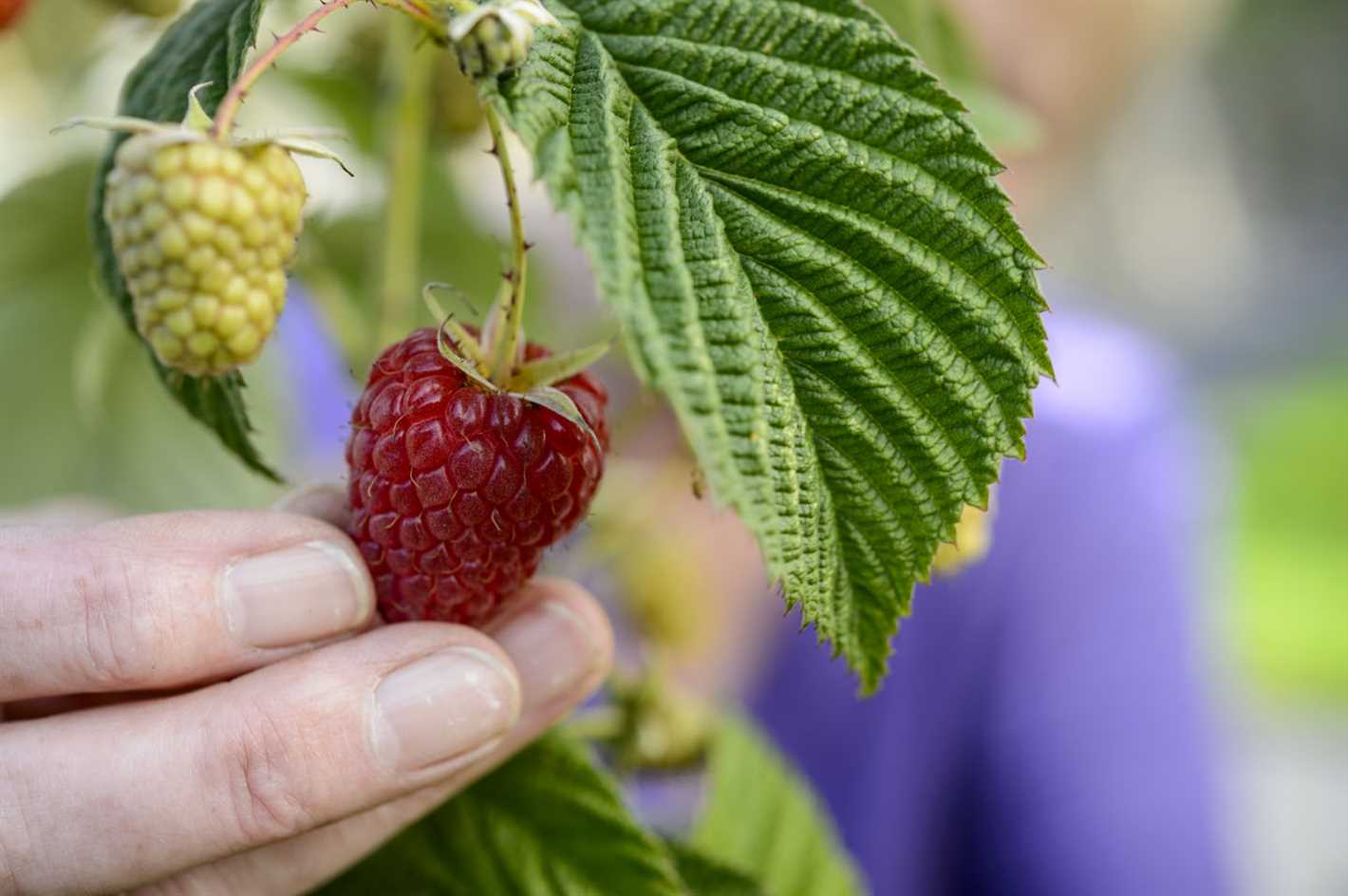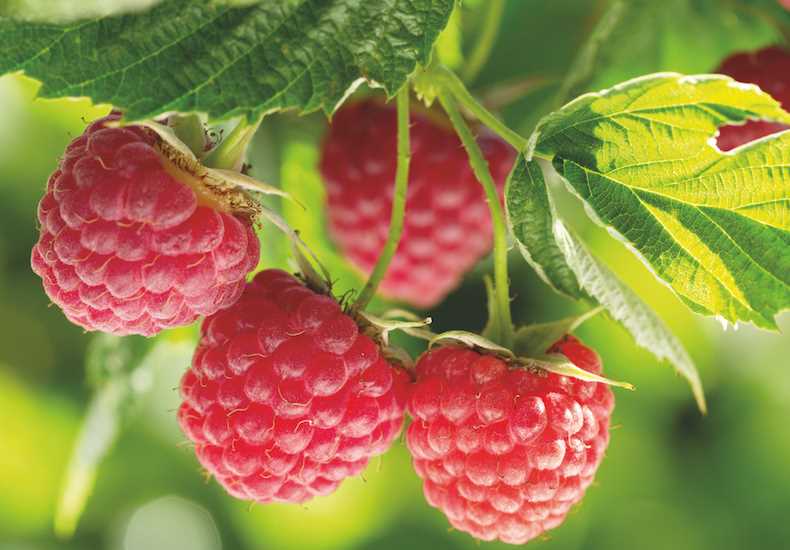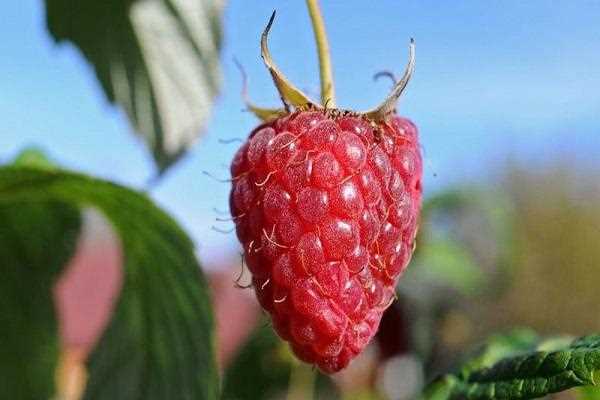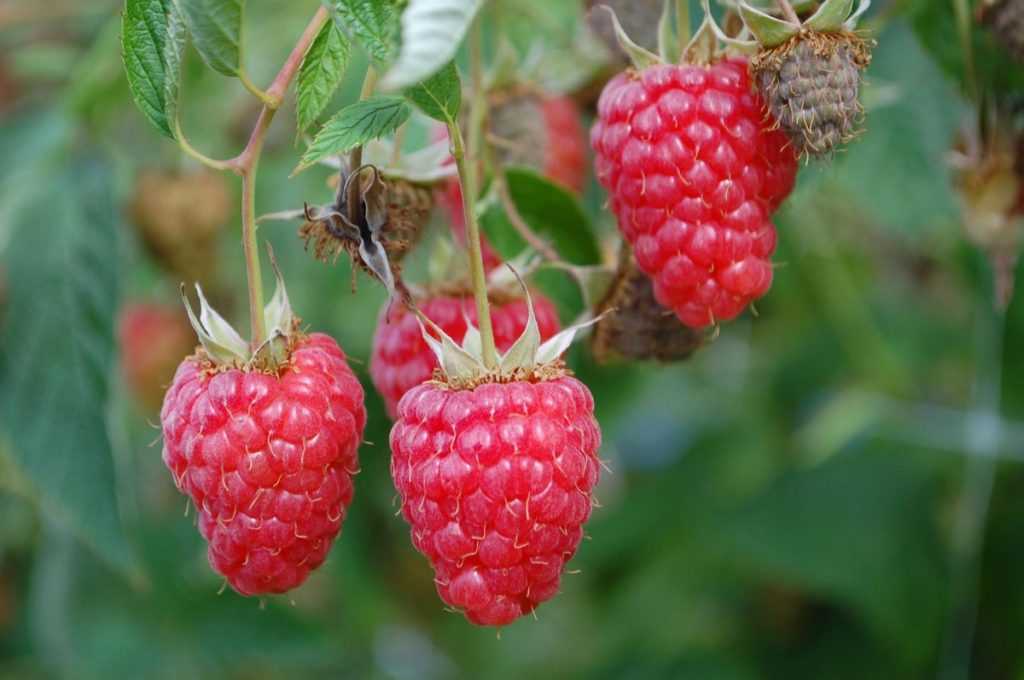- Importance of Caring for Remontant Raspberries
- 1. Maximizing Yield
- 2. Improving Berry Quality
- July-August Care: Watering and Mulching
- Watering
- Mulching
- Pruning and Training the Raspberry Canes
- 1. Pruning old canes
- 2. Selecting and training new canes
- 3. Pruning lateral shoots
- 4. Removing suckers
- Controlling Weeds and Pests
- Weed Control
- Pest Control
- Integrated Pest Management
- Fertilizing Remontant Raspberries
- When to fertilize
- Types of fertilizer
- Application method
- Recommended nutrient ratios
- Additional considerations
- Protecting Against Diseases
- 1. Powdery Mildew
- 2. Anthracnose
- 3. Botrytis Fruit Rot (Gray Mold)
- 4. Root Rot
- 5. Spider Mites
- Harvesting Remontant Raspberries
- Timing:
- Harvesting Methods:
- Harvesting Tips:
- Conclusion:
- Storing and Preserving the Berries
- 1. Harvesting:
- 2. Sorting and Cleaning:
- 3. Refrigeration:
- 4. Freezing:
- 5. Preserves and Jams:
- 6. Dehydration:
- Question-answer:
- How can I boost the yield of remontant raspberries in July-August?
- Is it advisable to use mulch for remontant raspberries in July-August?
- What are some common pests and diseases that affect remontant raspberries in July-August?
- What should I do with the raspberry canes after the fruiting period in July-August?
- How can I improve the berry quality of remontant raspberries in July-August?
- Video: Pruning Raspberries – Why? How? When? (2020)
July and August are crucial months for caring for remontant raspberries. These unique plants, also known as everbearing raspberries, have the ability to produce two crops of berries in a single growing season. By following a few key care tips during these months, you can boost both the yield and quality of your remontant raspberries.
One important aspect of caring for remontant raspberries in July-August is providing adequate water. These plants have a shallow root system, and dehydration can quickly lead to stress and reduced fruit production. It is recommended to water deeply and regularly, ensuring that the soil remains consistently moist but not waterlogged.
In addition to water, remontant raspberries benefit from regular feeding during this period. Fertilizers high in nitrogen can promote vegetative growth, while phosphorus and potassium help with flower and fruit development respectively. By using a balanced fertilizer or organic compost, you can provide the necessary nutrients for your plants to thrive.
Pruning is another important task to consider during July-August. Remontant raspberries produce their first crop of berries on the current year’s growth, so it is essential to remove any dead or weak canes to allow for new growth. This will not only improve air circulation but also ensure that the plant resources are focused on producing high-quality berries.
By following these care tips, you can maximize the yield and quality of your remontant raspberries. Whether you are an experienced gardener or a beginner, taking these steps during July and August will help ensure a bountiful harvest and delicious berries to enjoy throughout the season.
Importance of Caring for Remontant Raspberries
Remontant raspberries, also known as everbearing raspberries, are a type of raspberry plant that produces fruit on both new and old canes. These berries are known for their ability to produce multiple crops throughout the growing season, making them a popular choice for home gardeners and commercial growers. However, in order to ensure a healthy and abundant harvest, it is important to properly care for remontant raspberries during the summer months of July and August.
1. Maximizing Yield
Caring for remontant raspberries during July and August is crucial for maximizing yield. These months are when the first crop of berries begins to ripen, and providing the right care will help ensure that the plant has the resources it needs to produce a bountiful harvest.
- Watering: Regular watering is essential for remontant raspberries during the summer months. These plants have shallow root systems and need consistent moisture to thrive. Deep watering once or twice a week, depending on rainfall, can help prevent drought stress and ensure optimum fruit production.
- Fertilizing: Applying a balanced fertilizer in July can provide the necessary nutrients for the plant’s growth and fruit development. Look for a fertilizer with a higher phosphorus content to support flowering and fruiting. Follow the manufacturer’s instructions for application rates.
- Pruning: Pruning remontant raspberries during July and August is important for maximizing yield. Remove any dead or damaged canes, as well as any weak or overcrowded canes. This will help improve air circulation and sunlight penetration, resulting in healthier plants and bigger berries.
2. Improving Berry Quality
Proper care during July and August not only maximizes yield but also improves the quality of remontant raspberries. By providing the right conditions and addressing any potential problems, you can ensure that your berries are flavorful, juicy, and healthy.
- Pest and Disease Control: Monitor your remontant raspberries for any signs of pests or diseases, such as aphids, spider mites, or fungal infections. Promptly address any issues that arise by using organic pest control methods or treating with appropriate fungicides.
- Support and Trellising: As the raspberry canes grow and produce fruit, providing proper support becomes important. Install trellises or stakes to help keep the canes upright and prevent them from bending or breaking under the weight of the berries. This will also make harvesting easier.
- Harvesting: Harvest your remontant raspberries when they are fully ripe. This is usually indicated by their vibrant color and easy detachment from the plant. Pick the berries gently to avoid bruising or damaging them, and refrigerate them immediately for the best flavor and shelf life.
By emphasizing the importance of caring for remontant raspberries during July and August, you can enjoy a bountiful harvest of high-quality berries. Follow these tips and guidelines to maximize yield, improve berry quality, and ensure the overall health and productivity of your remontant raspberry plants.
July-August Care: Watering and Mulching
Watering and mulching are crucial tasks for caring for remontant raspberries in July and August to ensure optimal growth, yield, and berry quality. Both of these activities help to maintain soil moisture, control weed growth, and provide essential nutrients to the plants.
Watering
Remontant raspberries require regular and consistent watering throughout the summer months. Adequate moisture is necessary for the plants to produce abundant berries. Here are some watering guidelines:
- Water the plants deeply once or twice a week, providing enough water to moisten the soil to a depth of at least 6 inches.
- Ensure that the water reaches the root zone of the plants by using techniques such as drip irrigation or soaker hoses.
- Water early in the morning or in the evening to minimize evaporation and allow the plants to absorb moisture efficiently.
- Monitor the moisture level of the soil regularly to prevent overwatering or underwatering. Check the soil with your finger or a moisture meter.
Mulching
Mulching is an effective method for conserving soil moisture, suppressing weed growth, and providing insulation for the roots. Here’s how to mulch your remontant raspberry plants:
- Apply a layer of organic mulch, such as straw, wood chips, or compost, around the base of the plants, ensuring a thickness of 2-4 inches.
- Avoid piling mulch directly against the plant stems as it may cause rotting or disease.
- Make sure to replenish the mulch layer as needed throughout the summer to maintain its effectiveness.
- Mulching also helps to regulate soil temperature, preventing extreme heat or cold from affecting the plant roots.
By following proper watering and mulching practices during July and August, you can help your remontant raspberry plants thrive and maximize their yield and berry quality.
Pruning and Training the Raspberry Canes
Proper pruning and training of the raspberry canes are vital for improving yield and maintaining plant health. Here are some important techniques to follow:
1. Pruning old canes
Start by pruning out the old canes that have already fruited. These canes will be brown and woody in appearance. Cut them off at the base, as close to the ground as possible. Removing the old canes allows more energy to be directed towards the development of new canes and fruit.
2. Selecting and training new canes
Identify the new canes that have grown during the current season. These canes will have a green appearance. Select the healthiest, most vigorous canes, and prune out the weaker ones. Aim to have about 4-6 canes per plant for optimal yield.
Next, train the selected canes by tying them to a trellis or support system. This helps to keep the canes upright and prevents them from sagging or touching the ground. Use soft ties or plant clips to secure the canes to the support structure, ensuring that they have room for growth.
3. Pruning lateral shoots
Throughout the growing season, lateral shoots will develop from the main canes. These side shoots should be pruned to promote better air circulation and light penetration within the plant canopy.
Trim the lateral shoots back to about 8-12 inches in length. This will encourage the production of more fruiting buds along the main canes and improve berry quality.
4. Removing suckers

Suckers are shoots that grow from the base of the raspberry plants. These suckers can divert valuable resources and nutrients from the main canes, resulting in reduced fruit production and overall plant health.
Regularly check for and remove any suckers that emerge, cutting them off at ground level. This will help maintain the vigor and productivity of the main canes.
By following these pruning and training techniques, you can ensure that your remontant raspberries stay healthy, productive, and produce high-quality berries.
Controlling Weeds and Pests
Controlling weeds and pests in your remontant raspberry plantation is essential for maintaining the health and productivity of your plants. Weeds compete with raspberries for nutrients, water, and sunlight, while pests can cause damage to the berries and reduce the overall yield. Here are some strategies to help you control weeds and pests:
Weed Control
- Regularly inspect your raspberry plantation for weeds and remove them promptly. Hand-pulling or hoeing can be effective for small-scale weed control.
- Apply a layer of organic mulch around the raspberry plants to suppress weed growth. This can also help retain moisture in the soil.
- Avoid using herbicides near raspberry plants, as they can damage or kill the raspberries. If you need to use herbicides, choose a selective herbicide labeled for use in raspberry plantations and follow the instructions carefully.
Pest Control
- Monitor your raspberry plants regularly for signs of pest infestation, such as chewed leaves, wilting, or discolored berries.
- Encourage natural predators of pests, such as ladybugs, lacewings, or birds, by providing suitable habitats and food sources.
- If pest infestations become severe, consider using organic pest control methods, such as insecticidal soaps or neem oil. Follow the instructions on the product label for application and dosage.
- Practice good sanitation in your raspberry plantation by removing and disposing of any infested or diseased plant material promptly.
Integrated Pest Management
Implementing an integrated pest management (IPM) approach can be an effective way to control weeds and pests in your raspberry plantation. IPM combines various strategies, including cultural practices, biological controls, and chemical controls, to manage pests in a sustainable and environmentally-friendly manner. Consult with local agricultural extension services or experts for specific recommendations on integrated pest management for remontant raspberries in your region.
Fertilizing Remontant Raspberries
Fertilizing remontant raspberries is an essential part of their care routine in order to maximize their yield and berry quality. A well-balanced fertilizer application can provide the necessary nutrients for the plants to grow and produce an abundant crop.
When to fertilize
The timing of fertilizer application for remontant raspberries is crucial. Generally, it is recommended to apply fertilizer in early spring when the plants start their active growth, and again in mid-summer, around July or August.
Types of fertilizer
There are different types of fertilizers available for remontant raspberries, including organic and synthetic options. Organic fertilizers, such as compost or well-rotted manure, are often preferred as they provide a slow-release source of nutrients and improve soil structure. Synthetic fertilizers, on the other hand, provide an immediate nutrient boost but may require more frequent applications.
Application method
When applying fertilizer to remontant raspberries, it is important to avoid direct contact with the plant’s stems and leaves, as this can cause damage. Instead, spread the fertilizer evenly around the base of the plants, keeping it at a distance of about 6-8 inches from the stems. Gently work it into the soil using a rake or garden fork, being careful not to disturb the roots.
Recommended nutrient ratios
The nutrient requirements of remontant raspberries vary depending on the specific soil conditions and the age of the plants. In general, a balanced fertilizer with a ratio of 10-10-10 or 14-14-14 is suitable for most remontant raspberry varieties. However, it is recommended to conduct a soil test to determine the exact nutrient deficiencies and adjust the fertilizer application accordingly.
Additional considerations
In addition to regular fertilizer applications, it is important to ensure that remontant raspberries receive adequate water and sunlight. Watering should be done consistently, especially during dry periods, to prevent the plants from drying out. Providing them with 6-8 hours of direct sunlight per day will also promote healthy growth and fruit development.
By following these fertilization practices, remontant raspberries can thrive and produce a bountiful harvest of delicious berries with enhanced quality.
Protecting Against Diseases
Remontant raspberries are susceptible to various diseases that can significantly affect the yield and quality of the berries. It is crucial to protect the plants from these diseases to ensure a successful harvest. Here are some measures you can take to guard against common diseases:
1. Powdery Mildew
- Monitor for signs: Check the leaves, stems, and fruit for powdery white spots or grayish patches.
- Remove infected parts: Prune and dispose of infected leaves and stems to prevent the spread of the disease.
- Apply fungicides: If the powdery mildew persists, apply fungicides according to the manufacturer’s instructions.
- Improve air circulation: Trim nearby vegetation and ensure proper spacing between plants to enhance air movement.
2. Anthracnose
- Practice good sanitation: Remove and destroy any infected plant material, including pruned parts and fallen berries.
- Apply fungicides: Treat the plants with fungicides that are effective against anthracnose as a preventive measure or at the first sign of infection.
- Water the plants carefully: Avoid overhead watering, as wet conditions can promote the spread of anthracnose.
3. Botrytis Fruit Rot (Gray Mold)
- Remove infected berries: Regularly inspect the plants and remove any infected or rotting berries.
- Provide good air circulation: Prune the plants to improve ventilation and reduce humidity, which inhibits the growth of Botrytis.
- Avoid excessive nitrogen fertilization: High nitrogen levels can make plants more susceptible to Botrytis, so moderate fertilization is recommended.
4. Root Rot
- Plant in well-draining soil: Avoid waterlogged or heavy clay soils that can promote root rot.
- Ensure proper drainage: If necessary, create raised beds or improve field drainage to prevent water pooling around the plants.
- Practice crop rotation: Avoid planting raspberries and other susceptible plants in the same location for consecutive years.
- Avoid compacting soil: Do not walk or work the soil around the plants when it is excessively wet, as it can damage the roots and promote rot.
5. Spider Mites
- Regularly monitor for mites: Examine the undersides of leaves for tiny, crawling mites and fine webbing.
- Space plants adequately: Proper plant spacing allows for better air circulation, reducing the chances of mite infestation.
- Apply insecticidal soap or miticides: Treat the affected plants with appropriate products to control spider mite populations.
- Keep plants well-watered: Spider mites thrive in dry conditions, so ensure the plants receive adequate moisture.
By implementing these disease prevention measures, you can protect your remontant raspberries from common diseases and ensure a healthy and productive crop.
Harvesting Remontant Raspberries
The remontant raspberry plants produce two crops of berries each year: one in June-July and another in September-October. To ensure the best quality and flavor of the berries, it is important to know when and how to harvest them.
Timing:
The timing of the harvest depends on the specific variety of remontant raspberry and the region. Generally, the berries are ready to be picked when they are fully colored and easily detach from the plant with a gentle tug. It is important to check the berries regularly to catch them at the right time.
Harvesting Methods:
When harvesting remontant raspberries, it is best to use a gentle touch to avoid damaging the delicate berries. Here are a few methods you can use:
- Hand-Picking: The most common and traditional method is to pick the berries by hand. Carefully grasp the berry between your fingers and gently twist or pull it from the plant. Be sure to leave the stem on the plant.
- Scissors or Pruners: Another method is to use a pair of scissors or pruners to cut the berries from the plant. This can be useful if the berries are difficult to detach or if you have a large harvest.
Harvesting Tips:
Here are some tips to help you maximize the yield and quality of your remontant raspberry harvest:
- Harvest in the Morning: It is best to harvest the berries in the morning when they are cool and firm. This will help retain their flavor and minimize spoilage.
- Harvest Regularly: Harvest the berries as soon as they are ripe to encourage the plant to produce more berries. Leaving overripe or rotten berries on the plant can attract pests and diseases.
- Handle with Care: Handle the berries gently to prevent bruising and damage. Place them in a shallow container or basket to avoid crushing the lower layers of berries.
- Store Properly: If you are not consuming the berries immediately, store them in the refrigerator at a temperature of around 32-34°F (0-1°C) to maintain their freshness. Do not wash the berries until you are ready to use them.
Conclusion:
Harvesting remontant raspberries can be a delightful task, allowing you to enjoy the fruits of your labor. By following the proper timing and methods, you can ensure a bountiful harvest of delicious and healthy berries.
Storing and Preserving the Berries

Once your remontant raspberries are ripe and ready to be harvested, it’s important to store and preserve them properly to maintain their freshness and flavor. Here are some tips on how to store and preserve remontant raspberries:
1. Harvesting:
To ensure the best quality berries, harvest them early in the morning when they are cool and have the highest sugar content. Gently twist and remove the berries from the plant, being careful not to crush or bruise them.
2. Sorting and Cleaning:

Remove any damaged or overripe berries from the harvest. Rinse the berries gently under cold water to remove any dirt or debris. Pat them dry with a clean towel or paper towel.
3. Refrigeration:
Raspberries are highly perishable and should be refrigerated as soon as possible after harvesting. Place the berries in a shallow container lined with paper towels to absorb any excess moisture. Cover the container with a lid or plastic wrap and store them in the refrigerator at a temperature of about 32°F to 36°F (0°C to 2°C).
4. Freezing:
If you have a large harvest of remontant raspberries and want to preserve them for longer periods, freezing is a great option. Spread the cleaned and dried berries on a baking sheet in a single layer and place them in the freezer until they are frozen solid. Transfer the frozen berries to airtight containers or freezer bags and store them in the freezer for up to 12 months.
5. Preserves and Jams:
Another way to preserve remontant raspberries is by making preserves and jams. Follow a trusted recipe and sterilize the jars properly before filling them with the raspberry preserves. Seal the jars tightly and process them in a boiling water bath to create a vacuum seal. Store the jars in a cool, dark place for long-term storage.
6. Dehydration:

If you prefer dried raspberries, you can use a food dehydrator or an oven set at a low temperature to remove the moisture from the berries. Spread the clean raspberries in a single layer on a baking sheet and dry them until they become leathery. Store the dried raspberries in an airtight container in a cool, dry place.
By following these storage and preservation methods, you can enjoy your remontant raspberries for a longer period and savor their fresh flavors even after the harvesting season is over.
Question-answer:
How can I boost the yield of remontant raspberries in July-August?
In order to boost the yield of remontant raspberries during this time, it is important to provide them with adequate nutrient and water supply. Make sure to fertilize the plants with a balanced fertilizer, and water them regularly especially during hot and dry periods. Additionally, pruning the plants can help to encourage new growth and increase productivity.
Is it advisable to use mulch for remontant raspberries in July-August?
Yes, using mulch can be beneficial for remontant raspberries during this time. Mulching helps to conserve soil moisture, suppress weed growth, and regulate soil temperature. Apply a layer of organic mulch around the base of the plants, making sure to avoid direct contact with the stems. This will help to maintain optimal growing conditions and enhance the yield and berry quality.
What are some common pests and diseases that affect remontant raspberries in July-August?
Remontant raspberries are susceptible to various pests and diseases during this time. Common pests include aphids, spider mites, and raspberry fruitworms, while common diseases include raspberry leaf spot, anthracnose, and powdery mildew. It is important to regularly inspect the plants for any signs of infestation or disease, and take appropriate measures such as applying insecticides or fungicides as necessary.
What should I do with the raspberry canes after the fruiting period in July-August?
After the fruiting period, it is recommended to prune the raspberry canes. Cut back the canes that have finished producing fruit to the ground, leaving the new canes that will bear fruit the following year. This will help to maintain a well-organized and productive raspberry patch, and ensure a good harvest in the future.
How can I improve the berry quality of remontant raspberries in July-August?
To improve the berry quality of remontant raspberries during this time, it is important to provide them with ideal growing conditions. Make sure the plants receive sufficient sunlight, water, and nutrients. It is also beneficial to thin out the clusters of berries, leaving only the largest and healthiest ones to ripen. This will promote better air circulation and reduce the risk of disease, resulting in bigger and juicier berries.







